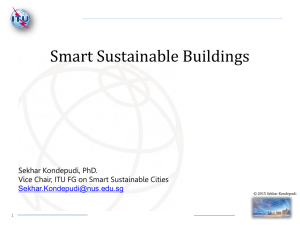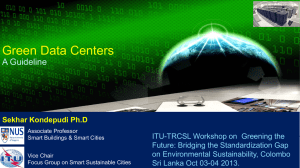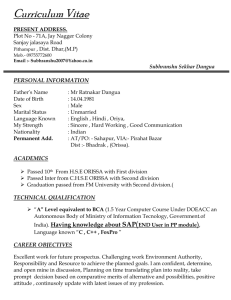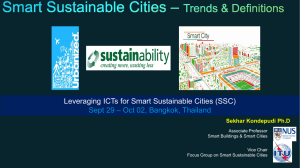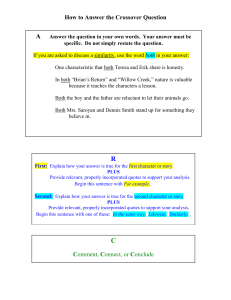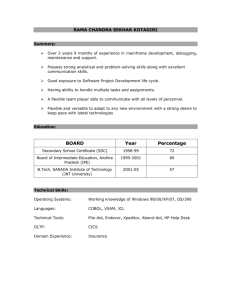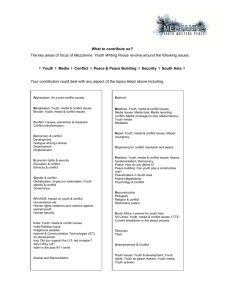Smart Buildings Leveraging ICTs for Smart Sustainable Cities (SSC) Sekhar Kondepudi Ph.D
advertisement
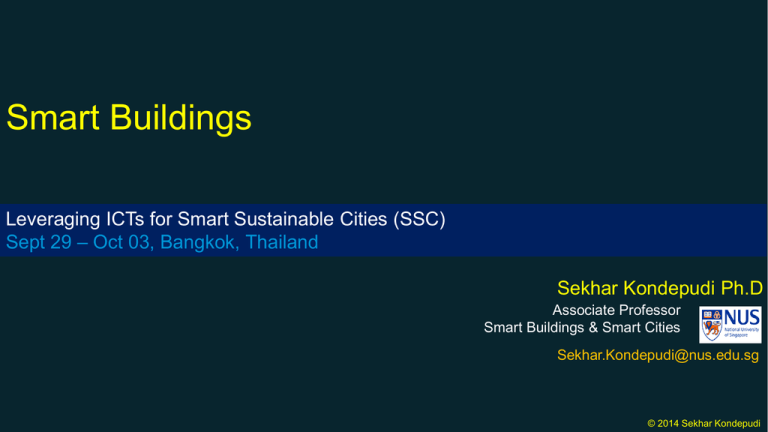
Smart Buildings Leveraging ICTs for Smart Sustainable Cities (SSC) Sept 29 – Oct 03, Bangkok, Thailand Sekhar Kondepudi Ph.D Associate Professor Smart Buildings & Smart Cities Sekhar.Kondepudi@nus.edu.sg © 2014 Sekhar Kondepudi 2 © 2013 Sekhar Kondepudi Key Elements of a Smart City City Management Education Real Estate & Buildings Public Safety Transport 3 HealthCare Utilities / Energy Environment © 2013 Sekhar Kondepudi • Where we spend 90% of our lives • Where we spend 70% of our electricity • Where we spend 50% of our energy • Where we spend 40% of our CO2 emissions • Natural counterbalance to fluctuating renewables • where we spend a lot of our $’s • 2/3rds of the occupants are uncomfortable 4 © 2014 Sekhar Kondepudi need 2 3 30 percent Real estate is the second largest expense on the income statement for most companies. In most organizations the real estate portfolio is on the balance sheet as the third most valuable or expensive single asset. Facilities investments and operating costs can be more than 30% of corporate annual spending. 2025 42 percent 1 By 2025, buildings worldwide will become the top energy consumers. Worldwide, buildings consume 42% of all electricity – up to 50% of which is wasted. Buildings are the number 1 contributor to global CO2 emissions. Source : IBM 5 © 2013 Sekhar Kondepudi Transportation 25% Buildings 50% Manufacturing 25% The Energy Consumption of IT Equipment in Buildings is Increasing Significantly 6 Sources: BOMA 2006, EIA 2006, AIA 2006 © 2013 Sekhar Kondepudi Lighting 11% Heating, Cooling & Ventilation 58% IT Equipment 25% Other 6% “… it takes twice as much energy to remove the heat generated … as it takes to run the equipment.” In France the energy use number for buildings is estimated to be 43 % which in turn contributes to 21 % of carbon emissions. It is estimated that by 2025, buildings will be the number ONE consumer of energy in the world. 7 © 2013 Sekhar Kondepudi 7 EIA 2008 8 © 2014 Sekhar Kondepudi Government Σ 9 Schools Universities Residential Hospitality Sports & Entertainment Energy Transportation Retail Source - Cisco Hospitals 9 © 2013 Sekhar Kondepudi 9 10 Home/Residential Office Shopping Transportation Imagine having quick and easy access to the information and government services you need to enhance your personal and professional life A building that knew when you arrived and left, automatically turned business applications on and off, sends a security alert when an unidentified package is left, or notifies you about peaking energy use Reserve and pay for parking before leaving home; receive real-time sales incentives on your mobile device upon entering the store; real-time video surveillance system Road, railway, and air transportation is the heart of any community. Where transportation services are smart, safe, energy efficient. Where you could access real-time transit information Sports School Wellness Government Connecting fans with their favorite teams--and each other--in entirely new ways with more immersive, interactive, and personalized experiences Imagine a school where learning extends beyond classroom walls, students are exposed to a wider world of information and experience, and people can collaborate in real time, Receive services from bestin-class healthcare organizations that provide an enhanced patient experience, privacy, and safety. Imagine a government experience that is engaging, where you can access the information you need to live, work, learn and play in that community © 2013 Sekhar Kondepudi Mechanical Systems • Heating • Ventilation • Air-Conditioning • Lighting • Power • Water • Elevators • Metering • Thermal storage, CHP 11 Safety & Security • Alarms • Fire Detection & Suppression • Intrusion • Access Control • Video Surveillance • Scanning • Evacuation • IAQ – Smoke, CO2, CO Communication & Networks • High Speed Internet • Common Network Infra • Wireless Mobility - WiFi • Remote Site Mobility -VPN • IP Telephony - VoIP • Audio -Video Conferencing • Visitor Management • Interactive Media / Signage © 2013 Sekhar Kondepudi Indoor Air Air Quality Filters Cameras Services Σ Air Handling Unit Controllers Cooling Coils Dampers SolarPV Exhaust Fans Smoke Detectors Cooling Towers VAV Elevators Lighting Halon Units Diffusers Zone Heating System Control Units Fans Cameras Intrusion Detectors Card Readers Access Management Chemical Water Control 12 Thermostats/ Humidistats Pumps Operators Chillers & Station Boilers Computer Room Fire Alarm Air Handlers Panels Rack/Server IDFPDU Parking Garage Electric, Gas, Heating Vending m/c Water Systems © 2013 Sekhar Kondepudi • Physical Services (Building Systems HVAC, Lighting, Elevators etc) • Infrastructural ICT Services (Pagers, Information System, Trouble Ticketing, Server farm, Office Systems, E-Mail, VoIP, VoD, Space-Management, Telecommunications) • Security Services (Fire Alarm, Intrusion, Inundation, CO, CO2, Nox, Access Control, Asset Tracking, CCTV) • Enterprise Services including CRM, ERP, Business and Financial Applications. 13 © 2013 Sekhar Kondepudi Today’s Disparate Building Systems Power Meters Electrical Lighting HVAC Elevators IT Access Control UPS Office Appliances 14 Renewable Sources © 2013 Sekhar Kondepudi Integrating Across Silos Power HVAC Lighting Access Video Security Life Safety IT Network Life Safety Systems White Space IT Apps Network Mgmt Systems Fire & Smoke Detectors, Sprinklers Servers Computers Wiring Closet Routers Switches Phones Network Power Monitoring Control Systems Emergency Power Supply Utilities 15 Building Automation Systems Lighting Control Active Access Control Biometrics Chillers Boilers Air Handlers Lighting Locks Doors Gates Man-traps Digital Video Recorder Video Analytics Cameras Housings © 2013 Sekhar Kondepudi Convergence 16 © 2013 Sekhar Kondepudi 17 Energy Management Green Buildings (LEED) Integrated BMS Remote Management Data Collection & Analysis ICT Convergence Smart Consumption Smart Grid Integration Net Zero & Sustainable Cloud Based Management Smart Buildings HVAC Controls Dedicated Subsystem Controls Basic Automation Digital Control (DDC) Individual BMS Systems Energy Savings Proactive Monitoring Policy Implementation Green & Optimization Control & Automation Comfort & Control Energy Savings Reactive Monitoring © 2013 Sekhar Kondepudi Source : Frost & Sullivan 18 Users Today's Internet Million Units 1000 2,500 500 600 900 1000 50,000 Computers As IP becomes pervasive, devices that do not exist today will be connected to the Internet. Phones Mobile Assets Static Assets Extended Internet Controllers Smart Sensors Microprocessors and Microcontrollers Extrapolated from Harbor Research, Forrester Research, 19 © 2013 Sekhar Kondepudi • Convergence is about gathering information and making decisions based on it. INTEGRATED • Without a good, robust network centric infrastructure, buildings can’t do that. • The fundamental objective is to get at all the data in a consistent manner. • Plumbing – Facilities • Control – Network . PROCESSES SYSTEMS IP Based Building Platform Safety Building and Security Automation IP Based Comm. Platform Data Voice Video PRODUCTS Security Fax Access HVAC Elevators Data & Text Fire Alarm Control Control Control Comm. Comm. Building Systems 20 Smart Building VoIP Video Communication Systems © 2013 Sekhar Kondepudi Visualization CIO Intelligent FM Interconnected Instrumented • Role-based Dashboards • Comparison of historical data with newly collected data • Data modeling and analytics • Building Management and Operations • Database management • Data aggregation from multiple • buildings and systems • Connectivity – wired/wireless • Open standards • Vendor Building Management Systems • Data aggregation – single building • Sensors and Meters Physical 21 • Bricks and Mortar Source : IBM © 2013 Sekhar Kondepudi ENTERPRISE APPLICATIONS Facility Management Maintenance Management IT Network Management IP Telephony IP Camera Wireless BMS Lighting Control Access Control Building Mgmt DVR BMS Boilers General Lighting VAV FCU AHU Channel Controllers FCU Heat Pump Chillers Occupancy Detectors DSI/DALI Interface Access Control Lighting Control Building Mgmt VAV Chilled Beam 22 CCTV Heat Pump Chilled Beam General Lighting Occupancy Detectors DSI/DALI Interface Source : Cisco © 2013 Sekhar Kondepudi Energy Management Building Management Facility Management Security Management Maintenance Management IT Network Management ENTERPRISE APPLICATIONS Middleware Server Disparate Protocols to Common Format + ICT Integration IP Camera IP Telephony Wireless Energy & Power Metering BMS Lighting Control CCTV UPS Monitoring Access Control DVR VAV Boilers FCU AHU Heat Pump Chillers Chilled Beam Fire Alarm System Smoke Sensor Door Controllers General Lighting Break Glass Channel Controllers Occupancy Detectors DSI/DALI Interface Intruder Panels Reader Technology Source : Cisco Sounder 23 © 2013 Sekhar Kondepudi 24 © 2013 Sekhar Kondepudi Smart Buildings 25 © 2013 Sekhar Kondepudi • An intelligent building is a dynamic and responsive architecture that provides every occupant with productive, cost effective and environmentally approved conditions through a continuous interaction among its four basic elements: places (fabric; structure; facilities); processes (automation; control; systems;) people (services; users) and management (maintenance; performance) and the interrelation between them. - CIB Working Group 1995 • "Intelligent buildings are buildings that through their physical design and IT installations are responsive, flexible and adaptive to changing needs from its users and the organisations that inhabit the building during its life time. The building will supply services for its inhabitants, its administration and operation & maintenance. The intelligent building will accomplish transparent 'intelligent' behaviour, have state memory, support human and installation systems communication, and be equipped with sensors and actuators." - Per Christianson (2000) • “Intelligent buildings should be sustainable, healthy, technologically aware, meet the needs of occupants and business and should be flexible and adaptable to deal with change” 56 • be flexible and responsive to different usage and environmental contexts • be able to change state (with long and short term memory) • support human communication • accomplish 'intelligent' behaviour and transparent intelligence • Integrate the different systems in a building to form a holistic system - Clements-Croome (2007) © 2014 Sekhar Kondepudi Smart Building? Smart Buildings are well managed, integrated physical and digital infrastructures that provide optimal occupancy services in a reliable, cost effective, and sustainable manner. It is a building that is managed comprehensively from design to demolition it is equipped with the right instruments and systems to enable monitoring and optimal operations it is integrated with the utility smart grid to take advantage of time-of-use electric rates, and to minimize consumption during peak hours it is capable of producing at least part of its energy needs; it might even capture rainwater, and minimize wastewater; and most importantly it has user interface tools to keep the occupants aware of the real time parameters of the building and empowers them to impact those parameters. 27 Source : IBM © 2013 Sekhar Kondepudi Smart Buildings 28 Multiple Sub-Systems © 2013 Sekhar Kondepudi Source IBM 29 Building Portfolio Water Energy Elevators Smart Meters, Use / Flow Sensing Smart Meters, Demand response Maintenance, Performance Occupancy Facilities Public Safety Lighting Waste Management Access/Security 24/7 Monitoring Carbon Compliance HVAC Fans, Variable Air Volume, Air Quality Condition Monitoring, Parking Lot Utilization Occupancy Sensing External Integration Maintenance Functionality checks, Detector service Analytics and Optimization Energy Use Weather Fire Asset Mgmt Utilities Citizen / Social Badge in, Cameras, Integration Perimeter, Doors, Floors, Occupancy Advertising Voice/Video/Data Voice / Video / Data Vertical Aspects Adapted / Modified from IBM 30 © 2013 Sekhar Kondepudi 31 • Wireless Sensor Networks • Energy & Environmental Data View, Compare, Share • Analytics Prediction Energy Savings Strategies Operational Optimization • Real-time Information / “Pulse” 31 © 2013 Sekhar Kondepudi Multi-Modal Sensor Network Concept Adapted from sMAP, UC Berkeley, Libelium 32 • Plug Load • Temperature • Humidity • Air Flow • Light • Noise • Motion • Visual 33 © 2014 Sekhar Kondepudi Measure, Monitor, Analyze, Optimize Control • Integrated solution for • • Automated Indoor / Outdoor Lighting Management • Desktop & Connected Devices Power Management • Scenes & Schedules for different zones • • Integration with Access Control (early stage) Technologies • Wireless Sensor & Control network • Over the Air Real-Time Updates • Cloud / Mobile Command & Control • Support for CFL as well as LED lighting • Anytime, Anywhere Access • Completely Automated Solution • Avoids manual interventions & errors • Cooling/Heating Systems (next stage) • User Comfort & Optimization • Almost switch-less environment • Providing benefits for • Retrofit / Brownfield Sites • Energy Savings • Efficient utilization of resources • Productive & Comfortable work environment • Ease of Installation/Maintenance Real Time Analytics • Facility wide data @ different level of granularity • Conference Room Utilization data 34 © 2014 Sekhar Kondepudi 700.00 600.00 500.00 400.00 300.00 200.00 100.00 0.00 Printer (MFD) - Idle State 70 60 Average Power (W) Power (Watt) Printer (MFD) - Idle State 0.00 20.00 40.00 60.00 80.00 100.00 120.00 140.00 160.00 Time (sec) Printer 1 Printer 2 Spike every 40 seconds (keep the drum warm ?) Spike lasts for 7-8 seconds Consumes up to 500W during that small timeframe Trend similar with Other MFD printer 50 40 30 20 10 0 5000 5200 5400 5600 5800 6000 6200 6400 6600 Time (sec) Snapshot of Field Data Captured at 15 sec intervals over multiple weeks Range between 50 and 60 W Energy Consumption Consistent with Detailed Per Second Data Assume 50 W for 12 hours a day X 365 Days X $ 0.25 / Kwh ~ $ 55.00 / year / printer At least 3000 such printers on NUS Campus = $ 165,000 savings annually 35 6800 7000 Measuring, Monitoring, Modeling and Managing Virtually All things are becoming INTELLIGENT Metering Real Time Data Integration Real Time + Historical Data Data Modeling + Analytics Data collection Feedback to user and data source; Incentives and actions to change behavior Our world is becoming INTERCONNECTED Sensing Feedback to user and data source; Incentives and actions to change behavior Our world is becoming INSTRUMENTED Data Integration Comparison of historical data, with newly collected data Data modeling and analytics to create insights to optimize smarter decisions Visualization + Decisions Source: IBM 36 © 2013 Sekhar Kondepudi The interconnection of physical assets and information technology can optimize efficiency, production and consumption in many types of buildings. Smarter Commercial Building Provides integrated facilities operations information for owners/operators in order to optimize energy usage and services based on tenant’s needs. Smarter Data Center Integrated facilities and IT insight to energy efficiency of datacenter and the correlation of IT and facilities information. 37 Smarter Cell Tower Integration of active and passive management enables optimized operations to reduce truck rolls. Smarter Campus Intelligent infrastructure platform and tools to manage plugin electric vehicle stations, buildings, badging, central utility plant © 2013 Sekhar Kondepudi The interconnection of physical assets and information technology can optimize efficiency, production and consumption in many types of buildings. Smarter Hotel Integration of all the guest subsystems of hotel that welcome guest according to their preferences and adds to convenience during stay. Smarter Hospital Sensor instrumentation used in real-time for asset location and automated workflows such as medical equipment maintenance. 38 Smarter Airport Provides efficient passenger and cargo services, climate control, wi-fi access, track maintenance tasks and help achieve security and safety compliance Smarter Government Building Utilize fully serviced office hubs and mobility tools to improve public services. Match occupancy levels with portfolio wide estates data to optimize building utilization. © 2013 Sekhar Kondepudi In Summary 39 © 2013 Sekhar Kondepudi • … solutions that turn buildings into living organisms: networked, intelligent, sensitive and adaptable … • … synergies between energy efficiency, comfort and safety and security …. • Building as a Network – Integration of Multiple Technologies (HVAC, Lighting, Plug Loads, Fire, Safety, Mobility, Renewable, Storage, Materials, IAQ etc) • Software – Efficiency, Automation & Control , Analytics & (Big ?) Data Management • Integration with Smart Grid • Distributed Energy • Coexist with Productivity, Efficiency, CSR, Sustainability and GHG reduction goals 40 © 2013 Sekhar Kondepudi • Variety of Building Functions / Sub-Systems all of which coordinate with one another • Sub-systems, components & devices which have nodes, end points and behave like a network in terms of their end use characteristics and interactivity with other nodes. • “System of Systems” or a “network of networks” • “Internet of Things” (IoT) for Buildings. • This is completely analogous to an IT or Data Communications network Example : Car Parking & Ventilation Example : Car Parking, Security, Access Control Lighting 41 © 2013 Sekhar Kondepudi IT Systems / Applications High-Speed Internet Wireless Mobility Remote Site Mobility-VPN IP Telephony Audio / Video Conferencing Visitor management Building Systems Lighting Elevators 24/7 Monitor HVAC Fire Video Surveillance Interactive media Access Digital signage Energy Adapted / Modified from CISCO 42 © 2013 Sekhar Kondepudi “The Skin” Dense sensor network on building surface and embedded in the systems and materials “The Circulatory System” The electrical system “The Brain” A policy engine at the center of the information systems 43 The Living Building “The Skeleton” The physical bricks and mortar of the building “The Nervous System” The IP Network “The Muscles” The devices and subsystems attached to the network © 2013 Sekhar Kondepudi 44 53 © 2014 Sekhar Kondepudi • Smart building technologies can improve buildings’ energy efficiency and indoor environmental quality. Green 69 Smart © 2014 Sekhar Kondepudi 70 © 2014 Sekhar Kondepudi
